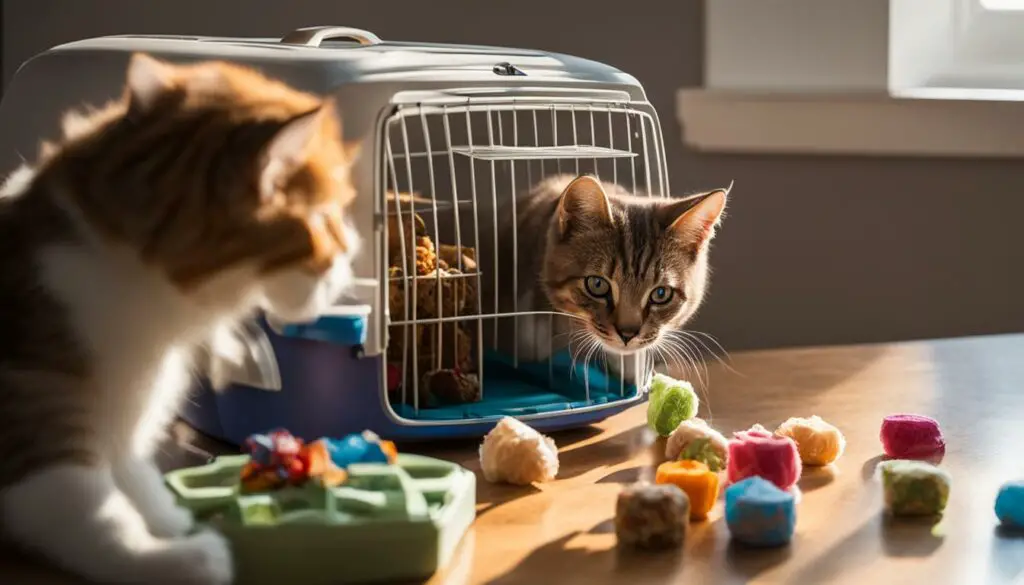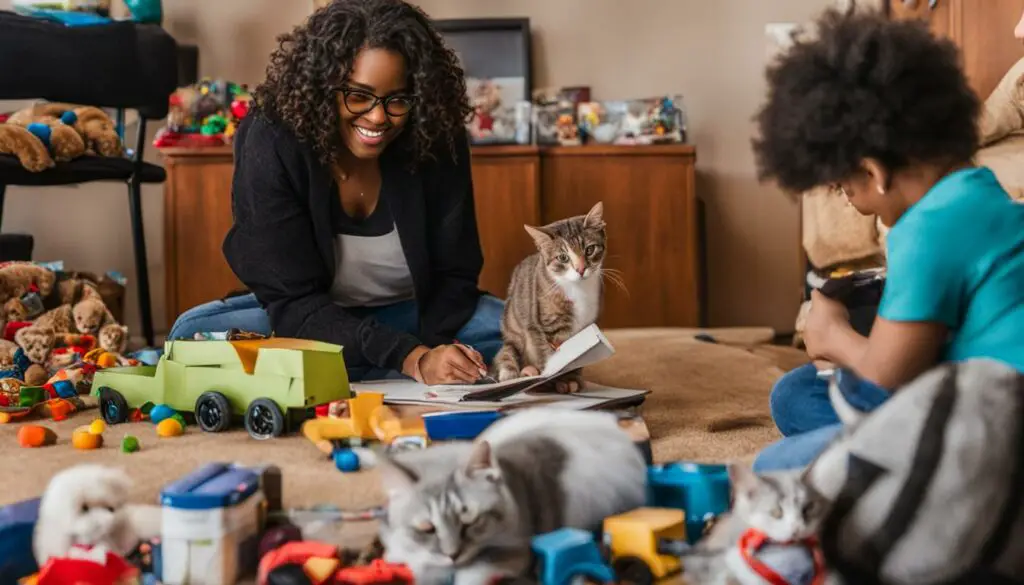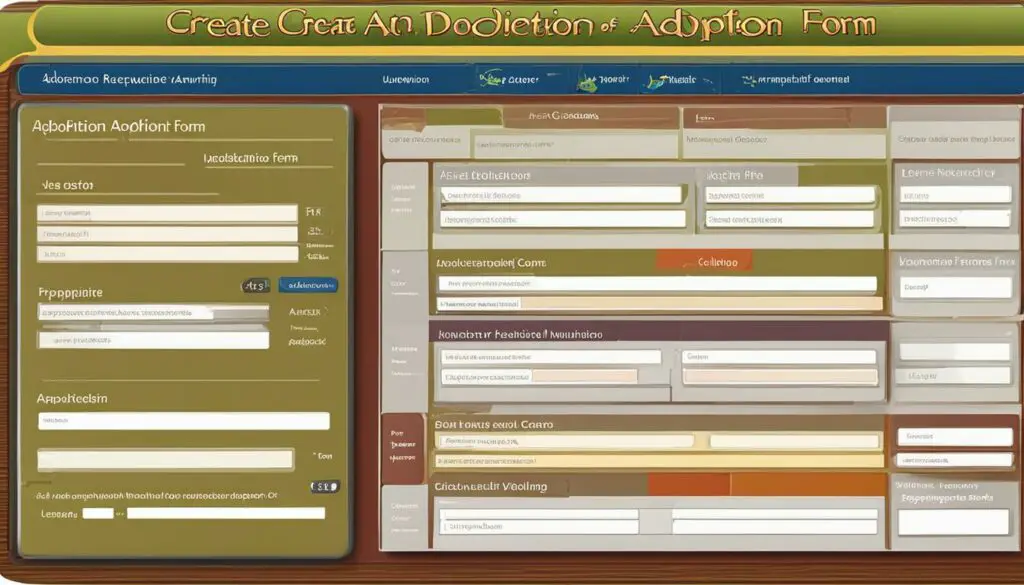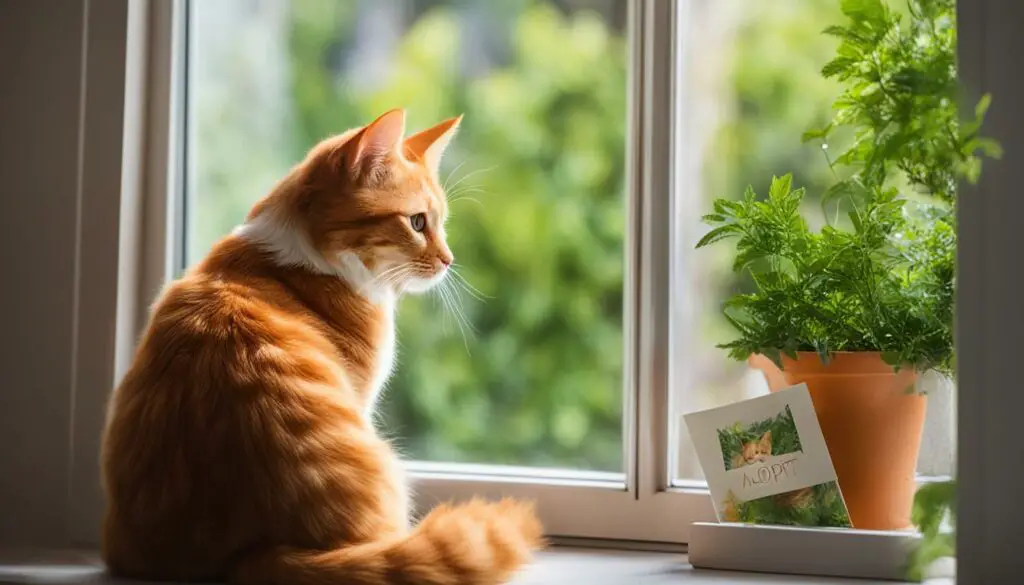Welcome to my guide on how to find a home for a cat! Whether you have stumbled upon a stray cat or need to rehome your own feline friend, this step-by-step guide will provide you with the information and tips you need to navigate the process successfully.
From checking for tags or microchips on a stray cat to notifying local shelters, I will guide you through what to do when you’ve found a stray. I’ll also show you how to create effective flyers and utilize online networks to spread the word about the cat needing a home. Preparing the cat for adoption and screening potential adopters are also crucial steps we’ll cover. And finally, I’ll offer some words of advice and encouragement to support you in your journey of finding a loving forever home for the cat.
So, let’s dive in and start this rewarding journey together!
Key Takeaways:
- Check for identification tags or microchips on stray cats to identify the owner.
- Notify local shelters and post flyers in the area where the cat was found.
- Create effective flyers and utilize online networks to attract potential adopters.
- Ensure the cat is healthy and up to date on vaccinations before adoption.
- Screen potential adopters to find a suitable environment for the cat.
What to do when you’ve found a stray
If you have found a stray cat, it’s important to take the necessary steps to ensure their well-being. Here are some actions to consider:
- Check for tags or a microchip: Look for any identification on the cat, such as a collar with tags or a microchip. This can help you identify the owner and reunite the cat with their family.
- Temporary tag: If there are no tags or a microchip, consider putting a temporary tag on the cat with your contact information. This way, if the owner is searching for their lost pet, they can reach out to you.
- Notify the local shelter: It’s important to inform your local animal shelter or rescue organization about the stray cat. They may have information about missing pets or be able to connect you with resources to help find the cat’s owner.
- Lost-and-found ads: Check online platforms, social networks, and community bulletin boards for lost-and-found ads related to cats. Posting a found cat ad can also help increase the chances of finding the owner.
Remember, even if you’re not legally required to notify the shelter, it’s still a good idea to let them know about the stray cat. They can provide guidance and assistance in reuniting the cat with their family.

Additional steps for caring for a stray cat
If you decide to provide temporary care for a stray cat while searching for the owner, here are some additional steps you can take:
- Provide food and water: Make sure the cat has access to fresh food and clean water. This will help ensure their basic needs are met.
- Create a safe space: Set up a comfortable area, such as a box with blankets, where the cat can rest and feel secure. This will provide them with a sense of safety.
- Contact local rescue organizations: Reach out to nearby rescue groups or cat shelters for advice and assistance. They may be able to provide resources, such as trap-neuter-return programs, to help with the stray cat.
- Consider veterinary care: If the cat appears injured or sick, it’s best to consult with a veterinarian. They can assess the cat’s health and provide necessary medical treatment.
By following these steps, you can help ensure the well-being of a stray cat and increase the chances of reuniting them with their owner or finding them a suitable home.
How to Get the Word Out
When you need to find a new home for a cat, it’s important to get the word out as widely as possible. There are several effective strategies you can use to increase visibility and find potential adopters.
Creating an Effective Flyer
One of the first steps is to create an eye-catching flyer that will grab people’s attention. Include a clear photo of the cat and a brief description highlighting their personality and needs. Use bold and large fonts to make the flyer easily readable from a distance. Don’t forget to include your contact information and any important details about the adoption process.
I found the flyer very informative and visually appealing. The photo of the cat instantly caught my attention, and the detailed description helped me understand if the cat would be a good fit for my home.
Advertise Online
Take advantage of the power of the internet by advertising the cat online. Use social media platforms, online classifieds, and pet adoption websites to reach a wider audience. Include the cat’s photo, description, and contact information in your online listings. You can also share the information with local animal rescue groups and shelters, as they may have followers who are interested in adopting a cat.
Contact Shelters and Rescue Groups
Reach out to local shelters and rescue groups in your area to see if they can help spread the word. They often have a network of adopters and can assist in finding suitable homes for cats in need. Provide them with all the necessary details about the cat, including their personality traits, medical history, and any special needs they may have.
By using these strategies, you can effectively get the word out about the cat needing a home and increase the chances of finding a loving forever home.
| Flyer Tips | Online Advertising | Shelter and Rescue Groups |
|---|---|---|
|
|
|

How to Prepare Your Cat for Adoption
Preparing your cat for adoption is essential to ensure that they are healthy, up to date on vaccinations, and ready for their new home. The first step is to schedule a veterinarian checkup. During this visit, the vet will examine your cat’s overall health, address any concerns, and ensure that all vaccinations are current. This is also an opportunity to discuss any behavioral or medical history that potential adopters should know. By providing this information, you are helping potential adopters make informed decisions and ensure the best care for your cat.
It’s important to gather all relevant information about your cat, including their medical records and any special needs they may have. This information should be shared with the adoption agency or potential adopters, as it helps them understand the cat’s unique requirements. Additionally, it’s crucial to ensure that your cat is spayed or neutered before adoption to prevent unwanted litters and promote their overall health.
Vaccination Schedule
| Vaccination | Recommended Schedule |
|---|---|
| Rabies | Annually or every 3 years, depending on local regulations |
| Distemper (FVRCP) | Initial series of vaccine shots, followed by boosters every 1-3 years |
| FeLV (Feline Leukemia Virus) | Initial series of vaccine shots, followed by boosters annually for outdoor cats or those at higher risk |
Once your cat is healthy and their vaccinations are up to date, you can focus on finding the perfect adopter. Be sure to include all necessary information about your cat in the adoption profile, such as their personality traits, preferences, and any special requirements. This will help potential adopters determine if your cat is the right fit for their home and lifestyle. By properly preparing your cat for adoption, you are increasing their chances of finding a loving forever home.

Quote:
“By providing all the necessary information and ensuring your cat’s health, you are setting them up for a successful adoption and a happy future in their new home.” – Animal Rescue Society
How to Screen Potential Adopters
When it comes to finding a suitable home for a cat, it’s crucial to screen potential adopters to ensure that they can provide the necessary care and environment for the cat. The screening process involves a counseling session where I ask questions to assess the adopter’s experience with cats, their living situation, and their ability to meet the basic needs of a cat. This process helps me determine if the adopter is a good fit for the cat and if the cat will thrive in their care.
During the counseling session, I focus on understanding the adopter’s knowledge of cat care, their previous experience with pets, and their commitment to providing a loving and safe home. I ask questions tailored to their circumstances, such as whether they have any other pets or children, their work schedule, and whether they have a suitable living environment for a cat. By gathering this information, I can gauge the adopter’s readiness and willingness to take on the responsibilities of cat ownership.
It’s important to remember that the screening process is not meant to be judgmental but rather to ensure the best possible outcome for both the cat and the adopter. By asking the right questions and actively listening to the adopter’s responses, I can identify any potential concerns or red flags that may indicate an unsuitable match. Ultimately, my goal is to find a loving and forever home for the cat, and screening potential adopters is a vital step in achieving that goal.

Meeting the Potential Adopter
When it comes to finding a new home for a cat, meeting the potential adopter is a crucial step in the process. This meeting allows both the adopter and the cat to get to know each other and determine if there is a connection. It’s an opportunity to observe how the cat responds to the potential adopter and vice versa, helping to assess compatibility. During this meeting, I introduce the cat to the potential adopter, allowing them to interact and spend time together. I observe their interactions closely, looking for signs of trust, affection, and compatibility.

If the cat shows signs of comfort and interest in the potential adopter, such as approaching them, purring, or seeking affection, it can indicate a positive connection. It’s important to ensure that the adopter understands the cat’s needs and is committed to providing a loving and safe home. I encourage the potential adopter to ask questions and offer guidance on how to care for the cat. The meeting also allows me to address any concerns or questions the potential adopter may have, ensuring that they are well-informed and confident about the adoption process.
This meeting serves as an important step in finding the right home for the cat. It allows both the cat and the potential adopter to assess their compatibility and determine if they are the right fit for each other. If the meeting is successful and both parties feel comfortable and confident, we can move forward with finalizing the adoption and ensuring a smooth transition for the cat into their new forever home.
Finalizing the Adoption
Once you have found the perfect adopter for the cat and both parties are ready to move forward, it’s time to finalize the adoption. This involves completing the necessary paperwork and paying any adoption fees. The adoption organization you are working with will provide you with the required forms and guide you through the process.
| Paperwork | Adoption fees |
|---|---|
| 1. Fill out the adoption application, providing your contact information and details about your home and experience with pets. | 1. Some adoption fees may apply, which go towards the care of other animals in need. |
| 2. Read and sign the adoption agreement, which outlines your responsibilities as the new pet owner. | 2. The adoption fees typically cover the cost of spaying/neutering, microchipping, and vaccinations. |
| 3. Provide any additional information or documentation requested by the organization. | 3. The fees may vary depending on the age and breed of the cat. |
It’s important to carefully review the paperwork and ask any questions you may have before signing. Make sure you fully understand the terms and conditions of the adoption. Once all the paperwork is completed and the adoption fees are paid, the adoption will be finalized. Congratulations, the cat is now officially a part of their new home!

Some Final Words of Advice and Encouragement for Cat Adoption
Adopting a cat is a rewarding experience that comes with its own set of challenges. As you embark on this journey, I want to offer you some words of advice and encouragement to help make the process smoother and more enjoyable.
Firstly, be patient. Bringing a new cat into your home can be a big adjustment for both you and the cat. Give them time to acclimate to their new surroundings and establish a sense of trust with you. It may take a little while for them to feel comfortable and show their true personality.
Remember to provide them with a safe and comfortable environment. Set up a cozy bed, provide scratching posts and toys, and create a designated area for their food and litter box. This will help them feel secure and at ease in their new home.
“Cats are independent creatures, but they still need love and attention.”
Additionally, cats are independent creatures, but they still need love and attention. Spend time playing with them, grooming them, and offering affection. This will help strengthen the bond between you and ensure their emotional well-being.
| Advice | Encouragement |
|---|---|
| Be patient and understanding as the cat adjusts to their new home. | Every cat deserves a loving and forever home. |
| Provide a safe and comfortable environment for the cat to thrive. | Your efforts in finding a suitable home make a difference in their lives. |
| Offer love, attention, and affection to the cat. | The reward of seeing them happy and loved in their forever home is worth it. |
Lastly, don’t be discouraged if the adoption process takes time. Finding the perfect home for a cat can sometimes require patience, but the joy of seeing them happy and loved in their forever home is worth it. Trust the process, follow your instincts, and know that you are making a positive impact on the life of a cat in need. Happy adoption!

Determining what sort of cat to adopt
When considering cat adoption, it is essential to determine what type of cat would be the best fit for your household. The age of the cat is an important factor to consider. Kittens are adorable but require more attention, training, and patience. Adult cats are often more independent and may already be trained. Senior cats can be a great choice for a more relaxed and low-energy lifestyle.
It is also crucial to consider if you are open to adopting a cat with special needs. These cats may require additional care and medical attention, but they can be just as loving and rewarding as any other cat. If you are considering adopting multiple cats, keep in mind that some cats may not get along well with others, so proper introductions and careful consideration of their compatibility are important.
By taking into account your lifestyle, preferences, and ability to meet the needs of different cat types, you can make an informed decision that will ensure a successful and fulfilling adoption experience for both you and your new feline companion.

Benefits of Adopting Different Cat Types
| Cat Type | Benefits |
|---|---|
| Kittens | – Adorable and playful – Opportunity to shape their personality and behaviors – Longer time for bonding |
| Adult Cats | – Usually already litter trained and may have basic obedience skills – More independent and require less supervision – Established personality and behavior |
| Senior Cats | – Often more mellow and low energy – Less demanding in terms of exercise and playtime – Provide a loving home for a cat in their golden years |
| Cats with Special Needs | – Rewarding experience of providing extra care and love – Make a difference in the life of a cat who may have otherwise been overlooked – Develop a strong bond through overcoming challenges together |
| Multiple Cats | – Provide companionship for each other – Reduce the chances of loneliness and boredom – Enjoy observing their interactions and play together |
Browsing local cat adoption listings
If you’re looking to adopt a cat, there are various options available to you. One of the most convenient ways to find your perfect feline companion is by browsing local cat adoption listings online. Websites like Adopt-a-Pet provide a comprehensive search feature that allows you to filter through thousands of available cats based on criteria such as breed, age, and location. This makes it easier to narrow down your search and find cats that meet your specific preferences and requirements.
In addition to online adoption listings, it’s also worth reaching out to local rescue organizations. These organizations often have their own websites or social media pages where they showcase adoptable cats. By contacting them directly, you can inquire about their available cats or even schedule a visit to meet them in person.
“Browsing local cat adoption listings online is a convenient way to find your perfect feline companion.”
If you have a specific breed in mind, you can also consider reaching out to specific breed rescue groups. These organizations specialize in rescuing and rehoming cats of a particular breed. They often have dedicated websites or online directories where they list adoptable cats of that breed. This allows you to find cats that match your desired breed characteristics and increase the chances of finding a cat that suits your preferences.
By exploring various sources such as online adoption listings, local rescue organizations, and breed-specific rescues, you can increase your chances of finding the perfect cat for your home. Remember to be patient and open-minded throughout the process, as the right cat may take time to find. Taking the time to browse adoption listings and reach out to different organizations will ultimately lead you to a wonderful cat who will bring joy and love into your life.

> Browse local cat adoption listings, whether through online platforms like Adopt-a-Pet or by contacting local rescue organizations and specific breed rescue groups. Take the time to search through available cats and schedule visits to meet them in person. By exploring different sources, you’ll increase your chances of finding the perfect feline companion for your home.
Arranging a visit
When you’re in the process of adopting a cat, it’s important to arrange a visit to meet the cat(s) you are interested in. This personal interaction allows you to assess the cat’s temperament and determine if there is a connection between you and the cat. Many rescue organizations and cat cafes offer the opportunity to book a time to meet adoptable cats and spend quality time with them.
During your visit, take note of how the cat responds to your presence and whether you feel a sense of compatibility. This is your chance to get to know the cat better and see if their personality aligns with your expectations. It’s important to spend enough time with the cat to truly gauge their behavior and determine if they will be a good fit for your home.
Cat cafes, in particular, provide a unique setting for meeting adoptable cats. These establishments combine the joy of enjoying a cup of coffee with the opportunity to interact with cats in a relaxed environment. It’s a wonderful way to observe the cats’ behavior and see how they interact with other visitors. If you prefer a more informal and cozy setting, a cat cafe might be the perfect place for you to meet your potential furry friend.

Benefits of arranging a visit:
- Allows you to personally interact with the cat to assess compatibility
- Gives you a chance to observe the cat’s behavior in person
- Provides a relaxed and comfortable environment for meeting adoptable cats, especially in cat cafes
“Meeting a cat in person is an essential step in the adoption process. It allows you to gauge their temperament and see if there is a connection. Don’t underestimate the power of personal interaction when finding your future feline companion.” – Cat Adoption Expert
Arranging a visit is an exciting part of the adoption journey. It allows you to determine if the cat you are interested in is truly the right fit for your home and lifestyle. Take your time during this visit and trust your instincts. When you find the cat that touches your heart, you’ll know it’s meant to be.
Filling out the necessary paperwork
When it comes to adopting a cat, filling out the necessary paperwork is an important step in the process. This is where you will provide your information and make a commitment to providing a loving and responsible home for the cat. Adoption applications may be completed online or in person, depending on the adoption organization’s requirements.
The adoption application will typically ask for details about your living situation and preferences for a pet. You may be asked about your past experiences with pets, your ability to provide a suitable home, and your willingness to meet the cat’s specific needs. It’s important to be honest and thorough in your responses, as this will help match you with the right cat.
Along with the adoption application, there may be paperwork requirements such as signing an agreement to provide proper care for the cat and paying any adoption fees. Adoption fees can vary depending on the organization and may cover expenses such as the cat’s vaccinations, spaying/neutering, and microchipping. Additionally, there may be requirements to register the cat’s microchip and provide proof of ownership once the adoption is finalized.
| Adoption Application Checklist |
|---|
| Complete the adoption application form |
| Provide accurate and detailed information about your living situation and pet preferences |
| Be prepared to answer questions about your past experiences with pets |
| Sign the agreement to provide proper care for the cat |
| Pay the adoption fees |
| Register the cat’s microchip |
It’s important to carefully read and follow all the instructions provided by the adoption organization to ensure a successful adoption process. By completing the necessary paperwork, you are taking the final steps towards welcoming a new feline companion into your home.

Gather the Required Documents
Before starting the adoption application process, gather any required documents that may be needed. This may include proof of identification, proof of residency or home ownership, and references. Having these documents readily available will make the application process smoother and quicker.
Consider the Adoption Fees
Adoption fees can vary widely depending on the organization and the services provided. Some organizations may include vaccinations, spay/neuter surgery, and microchipping in the adoption fee, while others may charge additional fees for these services. It’s important to understand the fees and what they cover before proceeding with the adoption process.
Review the Adoption Agreement
The adoption agreement is a legal document that outlines the responsibilities and expectations of both the adopter and the adoption organization. Take the time to carefully read and review the adoption agreement to ensure you understand and agree to all terms and conditions. If you have any questions or concerns, don’t hesitate to ask for clarification before signing the agreement.
Conclusion
Adopting a cat is a significant decision that requires careful consideration and preparation. Throughout this guide, I’ve provided you with step-by-step instructions on how to find a loving home for a cat. Whether you’ve found a stray or need to rehome your own pet, following these steps will ensure a successful cat adoption experience.
From checking for identification and notifying shelters to creating effective flyers and using online networks, I’ve shared the best strategies for getting the word out about a cat in need of a home. It’s crucial to prepare the cat for adoption by ensuring their health and gathering all necessary information for potential adopters.
Screening potential adopters and meeting them in person allows you to find the most suitable match for the cat. Finalizing the adoption involves completing the necessary paperwork and paying any adoption fees. Remember, patience and understanding are key as the cat adjusts to their new home.
By following this guide and seeking advice when needed, you can make a difference in a cat’s life by finding them a loving forever home. Thank you for considering cat adoption, and I wish you the best of luck in your journey to find the perfect feline companion!
FAQ
What should I do if I find a stray cat?
Check for tags or a microchip to identify the owner. If there are tags, contact the owner or the veterinarian clinic listed. If there are no tags, put a temporary tag on the cat with your contact information and notify your local shelter.
How can I get the word out about a cat needing a home?
Create an effective flyer with a description and photo of the cat. Advertise the cat online on adoption websites and social media. Contact shelters, rescue groups, and post flyers in the community. Spread the word through word of mouth.
How do I prepare a cat for adoption?
Take the cat to a veterinarian for a checkup and vaccinations. Gather all relevant information about the cat, including medical history and behavioral traits. Share this information with potential adopters.
How do I screen potential adopters?
Use a counseling process to ask questions about the adopter’s experience with cats, living situation, and ability to meet the cat’s needs. Ensure the adopter understands the responsibilities of owning a cat and is committed to providing a loving home.
How do I arrange a meeting between a potential adopter and the cat?
Arrange a meeting where the potential adopter can interact with the cat. Observe how the cat and potential adopter respond to each other to determine compatibility.
How do I finalize the adoption?
Complete the necessary paperwork and pay any adoption fees. Each adoption organization may have its own requirements. The paperwork typically includes information about the adopter and their agreement to provide proper care for the cat.
Any final advice for finding a home for a cat?
Be patient and understanding as the cat adjusts to their new home. Provide a safe and loving environment. Seek advice when needed and don’t be discouraged if the process takes time.
How do I determine the best type of cat to adopt?
Consider factors such as the cat’s age, special needs, and whether you are open to adopting multiple cats. Each age group has its own characteristics and care requirements.
Where can I browse local cat adoption listings?
Online adoption listings like Adopt-a-Pet allow you to search based on breed, age, and location. Local shelters, rescue organizations, and breed-specific rescue groups are also good sources.
How can I arrange a visit with a cat I’m interested in adopting?
Many rescue organizations and cat cafes offer the opportunity to book a visit to meet adoptable cats and assess compatibility.
What paperwork do I need to fill out for adoption?
Each adoption organization has its own application process. The application typically asks for information about your living situation, past experiences with pets, and commitment to providing a suitable home. Adoption fees may be involved.
Source Links
- https://resources.bestfriends.org/article/finding-new-home-pet
- https://www.adoptapet.com/blog/how-to-adopt-a-cat/
- https://be.chewy.com/bringing-home-a-cat-from-a-shelter-or-rescue-heres-everything-you-need-to-know/








